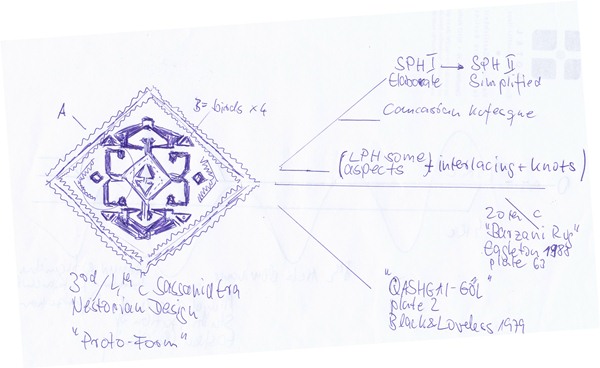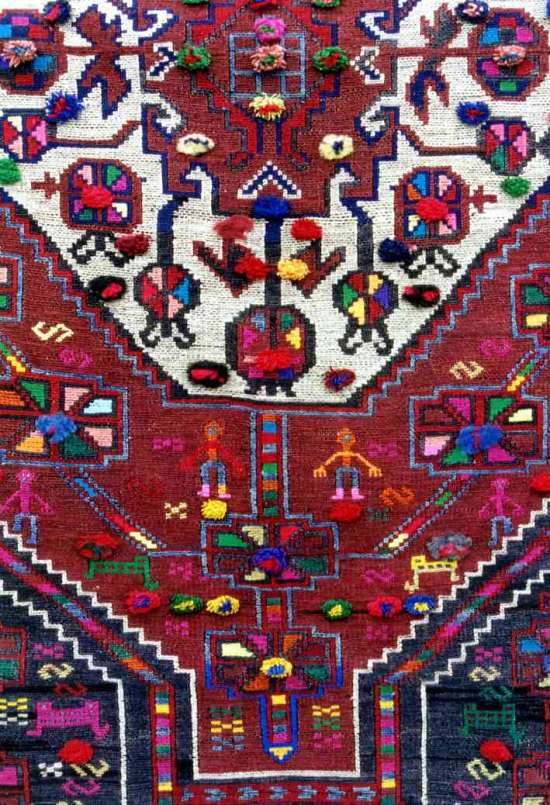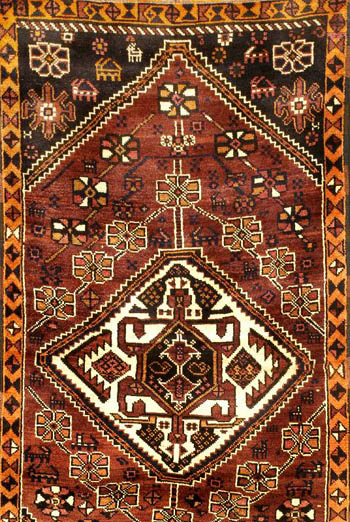| #1 Filiberto Boncompagni |
October 5th, 2014 11:32 AM |
For the record
Dear all,
When I first read Horst’s present essay, my first reaction was – for obvious reasons – to question the soundness of publishing it on Turkotek. But I quickly changed my mind: after all, Horst is imposing on us his “Nestorian theory” rather often since its first appearance in the thread About the Kufic border and people have the right to know what it’s all about.
For the record, here it’s the first Nestorian appearing (post # 239, May 10th, 2012):

(Actually the sketch refers to a “3-4th c "Sassanid Era Nestorian proto-form"; that particular definition ignominiously sunk when it crashed again a post of an outraged Marla Mallett.)
Insistently pressed to reveal if the source of the sketch had some real foundation Horst answered that yes, “The ink drawings are after an existing rug… I can’t do better than attribute it to a 15th to 19th c age span… I am working on an English language version of the paper presented last autumn and hope that it will find a publisher. Because of this, I would prefer not to show a picture of the rug here and now.” (abridged).
But, ladies and gentlemen Horst had shown it already, here on Turkotek - first in a detail on 09/22/2006, then the whole thing on 10/03/2006 - see the archived thread nude figures on rugs
And here they are, from that 2006
post.
Rug 1:
h
Rug 2:

and Rug 3:

On 09-26-2006, on the same thread, Horst added more details, omitted in the current Salon:
Of the three rugs he bought
the older sumak, which is at the core of
this Salon, was complete but he could afford only half of it
No surprise that now, in this salon, Horst
writes “the textile… appears to be the left one of
originally two flatwoven panels”… Omitting the fact that he saw the whole
piece, of course.
On 10-03-2006 the two older rugs were shown more entirely.
Rug 1:

and Rug 2:

Eight years later, of the three rugs, Rug 1 becomes possibly four (!!!) centuries older and the focus of the current Salon.
Rug 3 isn’t mentioned anymore.
Rug 2

from Horts’s own “Herki sumac” becomes a “Rug auctioned in Germany in 2005”
See following caption of the present salon: Plates 11,12: (from left) Rug auctioned in Germany in 2005; Eagleton (1988) plate 63 ‘Barzani rug’ ”
It also clear that footnote # 10 refers to rugs in plates 11 and 12, the 12 being the “Barzani rug”:
(the underlining is mine)
Please notice that, in this caption, the sumak becomes a “pile rug”.
Resuming: like illegitimated sons whose mention brings shame on the family, the younger rug is ignored; the other is disowned – it has even its “genre” changed.
I find very intriguing the omissions, especially of the fact that rug N. 2 “advertised as a Qashqai rug” (by whom, may I ask?) belonged to Horst.
Perhaps Horst doesn’t want us to recall that at the time he thought his three rugs were just three Herki sumac “with the same generic design”?
Above all, how can a sumak rug transmogrify into a pile rug? Is Horst taking us for a ride?
Anyway, I am aware that these are only trivial questions: reading this Salon, one should realize that there are bigger issues. And the answer to all of them should also be quite evident…
That’s why I’ll try to refrain from making any comment on its actual content. Suffice to say that it exceeded my expectations; I have to sincerely thank Horst for that.
Regards,
Filiberto
When I first read Horst’s present essay, my first reaction was – for obvious reasons – to question the soundness of publishing it on Turkotek. But I quickly changed my mind: after all, Horst is imposing on us his “Nestorian theory” rather often since its first appearance in the thread About the Kufic border and people have the right to know what it’s all about.
For the record, here it’s the first Nestorian appearing (post # 239, May 10th, 2012):

(Actually the sketch refers to a “3-4th c "Sassanid Era Nestorian proto-form"; that particular definition ignominiously sunk when it crashed again a post of an outraged Marla Mallett.)
Insistently pressed to reveal if the source of the sketch had some real foundation Horst answered that yes, “The ink drawings are after an existing rug… I can’t do better than attribute it to a 15th to 19th c age span… I am working on an English language version of the paper presented last autumn and hope that it will find a publisher. Because of this, I would prefer not to show a picture of the rug here and now.” (abridged).
But, ladies and gentlemen Horst had shown it already, here on Turkotek - first in a detail on 09/22/2006, then the whole thing on 10/03/2006 - see the archived thread nude figures on rugs
Quote:
|
Posted by Horst Nitz on 09-22-2006 09:24 PM Just to see what comes of it in the discussion, here I send three images of the same generic design (soumak, weft-float brocaded) by the Herki tribe in the Hakkari area; the oldest being 19th century, one mid 20th century, one of the 1990'ies. |
Rug 1:
h

Rug 2:

and Rug 3:

On 09-26-2006, on the same thread, Horst added more details, omitted in the current Salon:
Of the three rugs he bought
Quote:
|
I came at the beginning of October (1980), visited old places again and purchased three Herki sumacs |
Quote:
|
The rug is the left panel of two, that were originally sewn together; they were very ill-matched. There was an Istanbul businessman who was interested in just one panel, and as the price was unreasonably high and my grant pretty low, I grudgingly let go of the other half |
On 10-03-2006 the two older rugs were shown more entirely.
Rug 1:

and Rug 2:

Eight years later, of the three rugs, Rug 1 becomes possibly four (!!!) centuries older and the focus of the current Salon.
Rug 3 isn’t mentioned anymore.
Rug 2

from Horts’s own “Herki sumac” becomes a “Rug auctioned in Germany in 2005”
See following caption of the present salon: Plates 11,12: (from left) Rug auctioned in Germany in 2005; Eagleton (1988) plate 63 ‘Barzani rug’ ”
It also clear that footnote # 10 refers to rugs in plates 11 and 12, the 12 being the “Barzani rug”:
Quote:
|
(10) Eagleton (1988) plate 63 - depicts a more recent pile rug that is very similar in its principal design. He wonders how a Qashqai emblem could have found its way into a Barzani Kurdish rug from NE Iraq, 1000 miles away from Qashqai settlement areas. Yet another pile rug of this type has passed through auction in Germany in 2005. It was advertised as a Qashqai rug. Both pile rugs are of a more recent date, they are coarse weaves and lack the symbolic depth of the flat-weave. |
Please notice that, in this caption, the sumak becomes a “pile rug”.
Resuming: like illegitimated sons whose mention brings shame on the family, the younger rug is ignored; the other is disowned – it has even its “genre” changed.
I find very intriguing the omissions, especially of the fact that rug N. 2 “advertised as a Qashqai rug” (by whom, may I ask?) belonged to Horst.
Perhaps Horst doesn’t want us to recall that at the time he thought his three rugs were just three Herki sumac “with the same generic design”?

Above all, how can a sumak rug transmogrify into a pile rug? Is Horst taking us for a ride?

Anyway, I am aware that these are only trivial questions: reading this Salon, one should realize that there are bigger issues. And the answer to all of them should also be quite evident…
That’s why I’ll try to refrain from making any comment on its actual content. Suffice to say that it exceeded my expectations; I have to sincerely thank Horst for that.
Regards,
Filiberto
